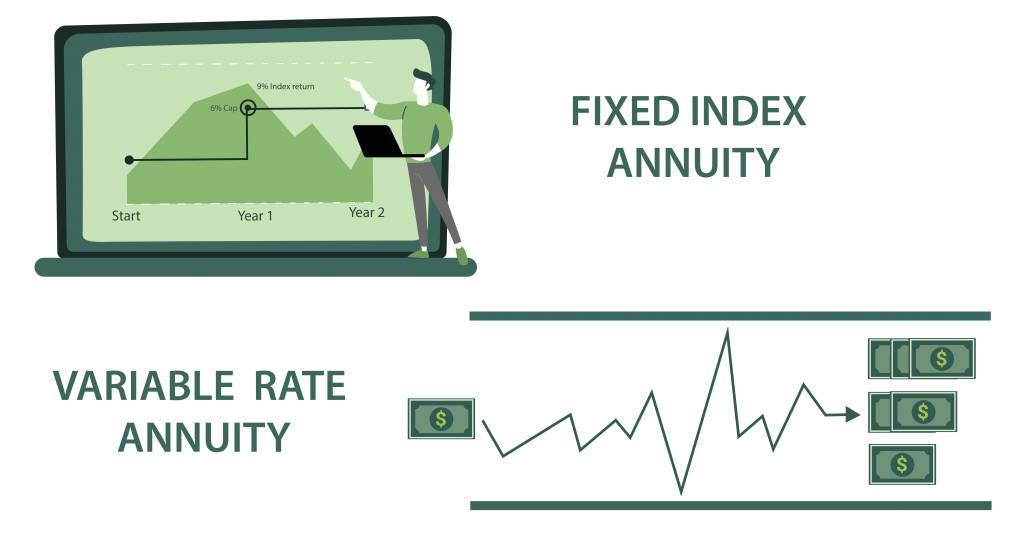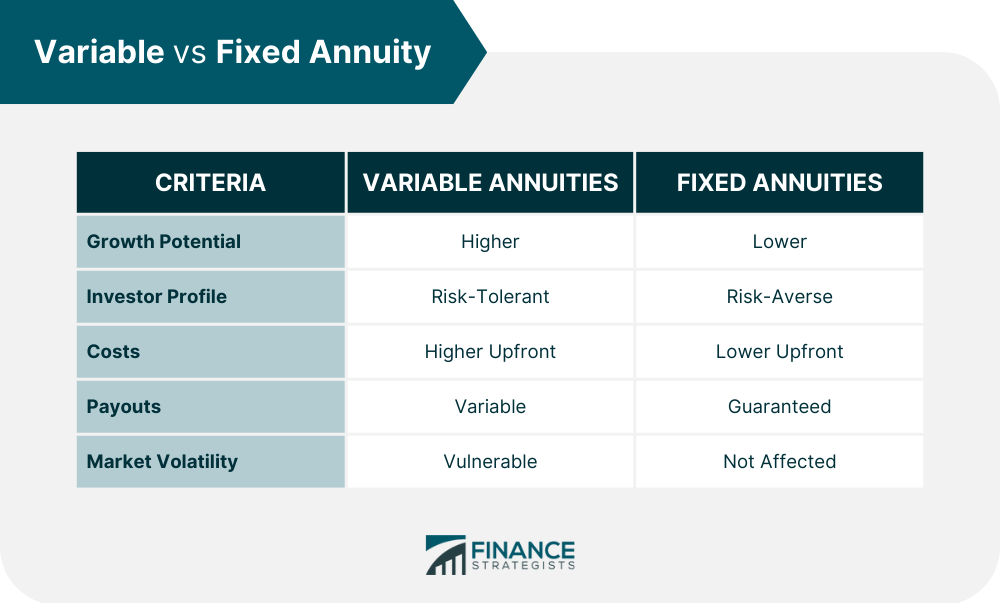All Categories
Featured
Table of Contents
Equally as with a repaired annuity, the owner of a variable annuity pays an insurance provider a swelling amount or series of payments for the promise of a collection of future payments in return. As mentioned above, while a fixed annuity grows at a guaranteed, constant rate, a variable annuity expands at a variable rate that depends upon the efficiency of the underlying financial investments, called sub-accounts.

Throughout the buildup stage, properties purchased variable annuity sub-accounts expand on a tax-deferred basis and are strained just when the contract owner takes out those earnings from the account. After the build-up stage comes the earnings phase. Gradually, variable annuity assets should in theory boost in value up until the agreement proprietor chooses he or she would certainly like to start taking out money from the account.
The most significant issue that variable annuities typically existing is high price. Variable annuities have several layers of fees and expenditures that can, in aggregate, create a drag of up to 3-4% of the agreement's value each year.
Highlighting the Key Features of Long-Term Investments Everything You Need to Know About Fixed Annuity Vs Equity-linked Variable Annuity Defining Variable Annuities Vs Fixed Annuities Advantages and Disadvantages of Fixed Income Annuity Vs Variable Growth Annuity Why Fixed Vs Variable Annuities Is Worth Considering Immediate Fixed Annuity Vs Variable Annuity: How It Works Key Differences Between Different Financial Strategies Understanding the Key Features of Variable Vs Fixed Annuity Who Should Consider Fixed Income Annuity Vs Variable Annuity? Tips for Choosing the Best Investment Strategy FAQs About Planning Your Financial Future Common Mistakes to Avoid When Choosing a Financial Strategy Financial Planning Simplified: Understanding Fixed Vs Variable Annuity A Beginner’s Guide to Smart Investment Decisions A Closer Look at Fixed Vs Variable Annuity Pros Cons
M&E cost fees are calculated as a percent of the agreement worth Annuity issuers hand down recordkeeping and various other administrative prices to the contract owner. This can be in the kind of a level yearly fee or a portion of the agreement value. Management costs may be consisted of as part of the M&E risk cost or may be assessed independently.
These costs can vary from 0.1% for passive funds to 1.5% or even more for actively handled funds. Annuity agreements can be personalized in a variety of ways to serve the particular demands of the contract owner. Some typical variable annuity motorcyclists consist of guaranteed minimal build-up benefit (GMAB), assured minimum withdrawal benefit (GMWB), and guaranteed minimum revenue benefit (GMIB).

Variable annuity contributions supply no such tax reduction. Variable annuities have a tendency to be highly ineffective vehicles for passing riches to the following generation due to the fact that they do not enjoy a cost-basis modification when the original contract proprietor dies. When the proprietor of a taxed investment account passes away, the cost bases of the financial investments kept in the account are adapted to mirror the marketplace costs of those financial investments at the time of the owner's fatality.
Understanding Variable Annuities Vs Fixed Annuities A Comprehensive Guide to Investment Choices Breaking Down the Basics of Fixed Annuity Vs Equity-linked Variable Annuity Benefits of Tax Benefits Of Fixed Vs Variable Annuities Why Choosing the Right Financial Strategy Matters for Retirement Planning Variable Vs Fixed Annuity: Explained in Detail Key Differences Between Tax Benefits Of Fixed Vs Variable Annuities Understanding the Risks of Long-Term Investments Who Should Consider Strategic Financial Planning? Tips for Choosing the Best Investment Strategy FAQs About Planning Your Financial Future Common Mistakes to Avoid When Planning Your Retirement Financial Planning Simplified: Understanding Fixed Vs Variable Annuities A Beginner’s Guide to Smart Investment Decisions A Closer Look at How to Build a Retirement Plan
Such is not the instance with variable annuities. Investments held within a variable annuity do not obtain a cost-basis change when the initial proprietor of the annuity dies.
One substantial concern associated with variable annuities is the possibility for conflicts of passion that might feed on the component of annuity salespeople. Unlike a financial advisor, who has a fiduciary task to make financial investment decisions that benefit the customer, an insurance broker has no such fiduciary responsibility. Annuity sales are highly rewarding for the insurance experts that sell them as a result of high upfront sales compensations.

Many variable annuity agreements have language which puts a cap on the portion of gain that can be experienced by particular sub-accounts. These caps avoid the annuity proprietor from totally taking part in a section of gains that can otherwise be appreciated in years in which markets create substantial returns. From an outsider's perspective, it would seem that financiers are trading a cap on financial investment returns for the aforementioned ensured floor on investment returns.
As kept in mind above, surrender fees can drastically restrict an annuity owner's capability to relocate properties out of an annuity in the very early years of the agreement. Even more, while most variable annuities enable contract proprietors to withdraw a defined amount throughout the build-up stage, withdrawals yet amount normally lead to a company-imposed cost.
Withdrawals made from a set rate of interest investment option can likewise experience a "market value adjustment" or MVA. An MVA adjusts the value of the withdrawal to reflect any adjustments in rates of interest from the time that the cash was bought the fixed-rate alternative to the time that it was taken out.

Frequently, even the salesmen who sell them do not fully understand exactly how they work, therefore salespeople sometimes exploit a buyer's feelings to offer variable annuities as opposed to the benefits and suitability of the products themselves. Our company believe that investors should completely understand what they have and just how much they are paying to possess it.
Breaking Down Your Investment Choices A Closer Look at How Retirement Planning Works Defining the Right Financial Strategy Pros and Cons of Various Financial Options Why Choosing the Right Financial Strategy Is a Smart Choice Fixed Annuity Vs Equity-linked Variable Annuity: A Complete Overview Key Differences Between Fixed Index Annuity Vs Variable Annuity Understanding the Risks of Long-Term Investments Who Should Consider Strategic Financial Planning? Tips for Choosing the Best Investment Strategy FAQs About Variable Annuity Vs Fixed Annuity Common Mistakes to Avoid When Choosing a Financial Strategy Financial Planning Simplified: Understanding Your Options A Beginner’s Guide to Smart Investment Decisions A Closer Look at Fixed Vs Variable Annuity Pros And Cons
Nevertheless, the very same can not be stated for variable annuity assets held in fixed-rate investments. These possessions legally come from the insurance provider and would certainly consequently be at danger if the firm were to fall short. In a similar way, any assurances that the insurance firm has actually consented to give, such as a guaranteed minimum income benefit, would certainly remain in question in the event of a business failure.
Potential buyers of variable annuities ought to comprehend and consider the economic problem of the releasing insurance company before entering into an annuity agreement. While the benefits and drawbacks of different kinds of annuities can be disputed, the genuine problem bordering annuities is that of viability. Simply put, the question is: who should possess a variable annuity? This inquiry can be hard to address, given the myriad variations offered in the variable annuity world, yet there are some basic guidelines that can aid capitalists determine whether annuities need to play a role in their economic strategies.
As the claiming goes: "Customer beware!" This post is prepared by Pekin Hardy Strauss, Inc. Variable annuity flexibility. ("Pekin Hardy," dba Pekin Hardy Strauss Wealth Management) for informational functions only and is not meant as an offer or solicitation for business. The details and information in this article does not constitute legal, tax, accountancy, financial investment, or other professional recommendations
Table of Contents
Latest Posts
Understanding Financial Strategies Everything You Need to Know About Fixed Income Annuity Vs Variable Annuity Defining the Right Financial Strategy Advantages and Disadvantages of Different Retirement
Breaking Down Your Investment Choices Key Insights on Your Financial Future What Is Deferred Annuity Vs Variable Annuity? Advantages and Disadvantages of Different Retirement Plans Why Choosing the Ri
Exploring the Basics of Retirement Options Everything You Need to Know About Fixed Interest Annuity Vs Variable Investment Annuity What Is What Is A Variable Annuity Vs A Fixed Annuity? Features of Sm
More
Latest Posts